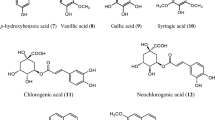Abstract
Indian traditional medicinal plant Piper attenuatum (Buch-Ham) has been investigated for its antioxidant and anticancer activity. Three extracts were prepared using ethyl acetate, ethanol and methanol. In vitro antioxidant activity was performed by ABTS {2,2′-azino-bis(3-ethylbenzothiazoline-6-sulphonic acid)} free radical scavenging method. All three extracts reduced the free radicals produced by ABTS in a concentration-dependent manner which could be compared to the standard (gallic acid). Invitro anticancer activity of all extracts was carried out by MTT (3-(4,5-dimethylthiazol-2-yl)-2,5-diphenyltetrazolium bromide) assay method against MCF7 (Michigan Cancer Foundation-7) cell lines. None of the extract showed anticancer activity when compared with the standard (mitomycin C) indicating that P. attenuatum is deprived of antiproliferative or cytotoxic components.



Similar content being viewed by others
References
Aragon SM, Basabe B, Benedi JM, Villar AM (1998) Antioxidant activity of Vaccinium myrtillus L. Phythér Res 12:S104–S106
Auddy B, Ferreira M, Blasina F, Lafon L, Arredondo F, Dajas F, Tripathi PC, Seal T, Mukherjee B (2003) Screening of antioxidant activity of three Indian medicinal plants traditionally used for the management of neurodegenerative diseases. J Ethnopharmacol 84:131–138
Chen I, Chang H, Yang H, Chen G (2004) Evaluation of total antioxidant activity of several popular vegetables and Chinese herbs: a fast approach with ABTS/H2O2/HRP system in microplates. J Food Drug Anal 12:29–33
De Zwart LL, Meerman JH, Commandeur JN, Vermeulen NP (1999) Biomarkers of free radical damage applications in experimental animals and in humans. Free Radic Biol Med 26:202–226
Divisi D, Di Tommaso S, Salvemini S, Garramone Crisci (2006) Diet and cancer. Acta Biomed 77:118–123
Jadhav HR, Bhutani KK (2002) Antioxidant properties of Indian medicinal plants. Phythér Res 16:771–773
Khare CP (2007) Indian medicinal plants—an illustrated dictionary, 2nd edn. Springer, New York, p 489
Kokate CK, Purohit AP, Gokhale SB (2008) Text book of pharmacognosy, 42nd edn. Nirali Prakashan, Pune, p 11.58
Kupchan Morris, Hemingway Richard, Smith Roger (1969) Tumor inhibitors XLV crotepoxide, a novel cyclohexane diepoxide tumor inhibitor from Croton macrostuchys. J Org Chem 34:3898–3902
Parmar V, Jain S, Gupta S, Talwar S (1998) Polyphenols and alkaloids from Piper species. Phytochemistry 49:1069–1078
Slater TF (1984) Free radical mechanisms in tissue injury. Biochem J 222:1–15
Suresh Kumar MA, Mangalam N, Hema PS, John M, Santhosh Kumar TR (2007) Pinocembrin triggers bax-dependent mitochondrial apoptosis in colon cancer cells. Mol Carcinog 46:231–241
Vani T, Rajini M, Sarkar S, Shishoo CJ (1997) Antioxidant properties of the ayurvedic formulation—triphala and its constituents. Pharm Biol 35:313–317
Acknowledgments
We acknowledge Dr. C. V. Chandrashekhar, Natural remedies, Bengaluru, for helping us in carrying biological activity studies. We also acknowledge Dr. M. M. Rao, The Director, NIAPR, Patiala, for providing the laboratory facilities for this study.
Author information
Authors and Affiliations
Corresponding authors
Additional information
Renu Ohlyan and Ajit Kandale contributed equally to this study.
Electronic supplementary material
Below is the link to the electronic supplementary material.
Rights and permissions
About this article
Cite this article
Ohlyan, R., Kandale, A., Deora, G.S. et al. In vitro screening of dry fruit extracts of Piper attenuatum for antioxidant and anticancer activity. Med Chem Res 22, 1365–1370 (2013). https://doi.org/10.1007/s00044-012-0122-y
Received:
Accepted:
Published:
Issue Date:
DOI: https://doi.org/10.1007/s00044-012-0122-y




